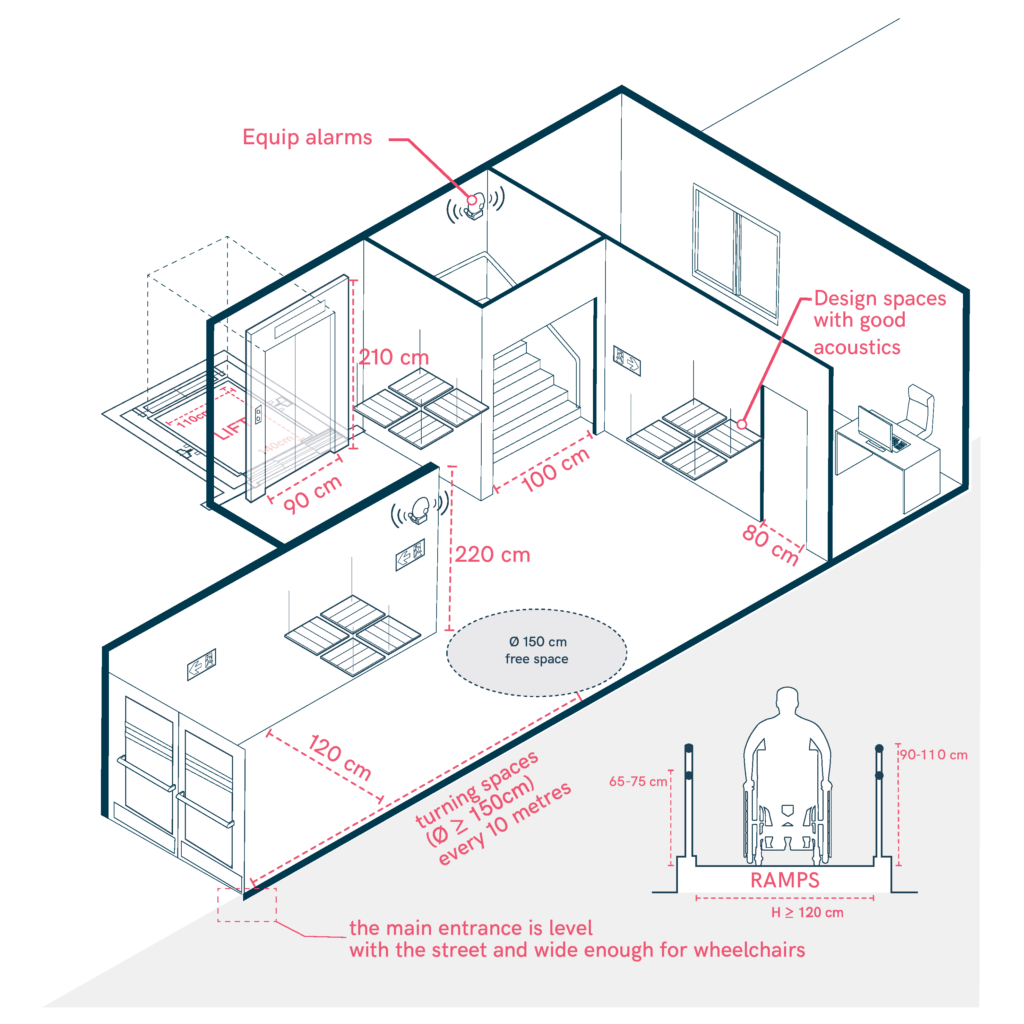Circulation Within Educational Centers
Ensuring ease of movement within schools allows everyone, including those with disabilities, to navigate spaces comfortably. Attention to spatial design, signage, and layout dimensions is essential. Creating a truly inclusive school means ensuring that everyone can move around the space with ease and independence. From entering the building to moving between classrooms or using the toilet, accessibility must be a priority. Thoughtful design, clear signage, and attention to detail are key to achieving this. Below are some important recommendations to make our educational centres more accessible and welcoming for all.

- Ensure the main entrance is level with the street and wide enough for wheelchairs and two people to pass comfortably.
- If there are stairs, provide ramps, lifts, or elevators to facilitate movement between levels.
- Clearly mark emergency exits with bright colours and illuminated signs.
- Maintain a minimum clear headroom of 220cm to create a spacious feel.
- Corridors should be at least 120cm wide, with turning spaces (Ø ≥ 150cm) every 10 metres.
- Door openings should have a minimum width of 80cm.
- Ramps should be at least 120cm wide, with a maximum gradient of 10% (depending on length) and handrails on both sides.
- Staircases should have a minimum width of 100cm (depending on expected foot traffic), handrails on both sides, and uniform step dimensions.
- Lifts should have ample space (minimum 110cm x 140cm), wide doors, and sufficient turning space (Ø ≥ 150cm).
- Use clear and easy-to-understand signage with pictograms at eye level for better navigation.
- Equip alarms with both audible and visual signals to accommodate different needs.
- Design spaces with good acoustics, especially for people with hearing impairments.
Sources
- https://accessible-eu-centre.ec.europa.eu/content-corner/digital-library/en-172102021-accessibility-and-usability-built-environment-functional-requirements_en
- https://www.miteco.gob.es/fr/ceneam/recursos/materiales/guia-diseno-entornos-escolares.html
- https://www.codigotecnico.org/pdf/Documentos/SUA/DccSUA.pdf
- https://www.cocemfe.es/wp-content/uploads/2020/02/Guia-basica-accesibilidad-centros-educativos.pdf
- https://www.oficinadeaccesibilidaduniversal.es/doc/educativa/centros-educativos/Accesibilidad%20cognitiva%20en%20centros%20educativos.pdf
- https://afaunamuno.org/wp-content/uploads/2023/02/Criterios-Intervencion-EE-30Mar_22.pdf
- Carers
- Children
- Cognitive
- Cognitive abilities
- Decolonial perspective
- Digital
- Digital barrier
- Enviroment
- Environmental
- Gender and generations
- Gender perspective
- Hearing impairment
- Low-education
- Low-income
- Older people
- Other
- Physical abilities and features
- Sensory and Physical
- Socioeconomic
- Visual impairment